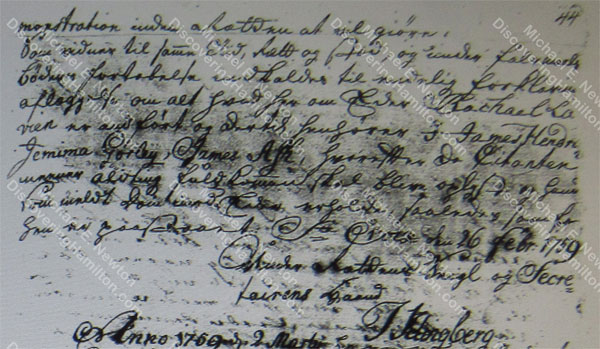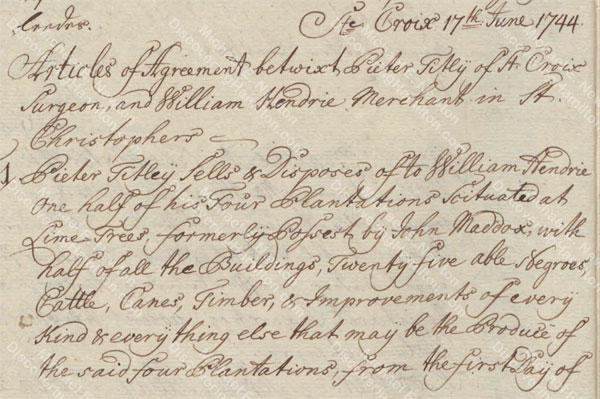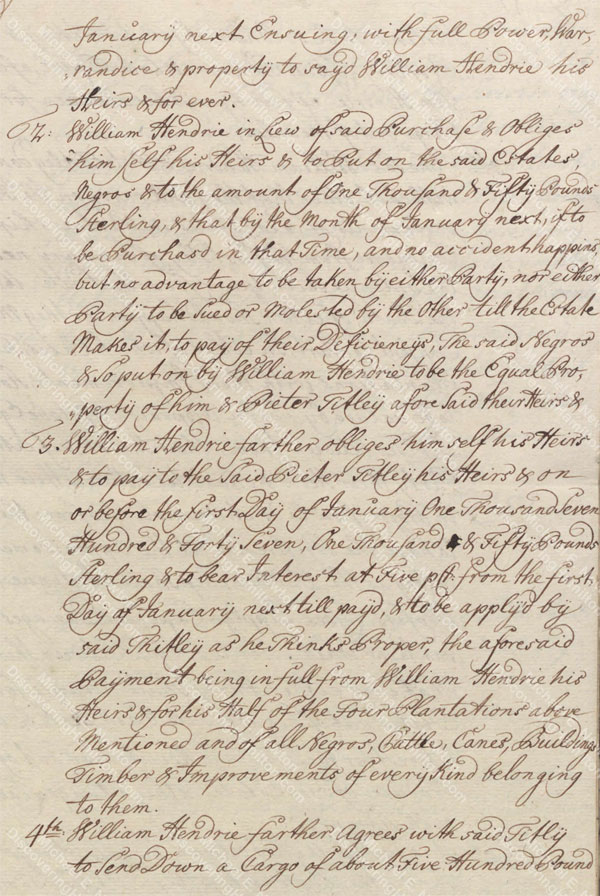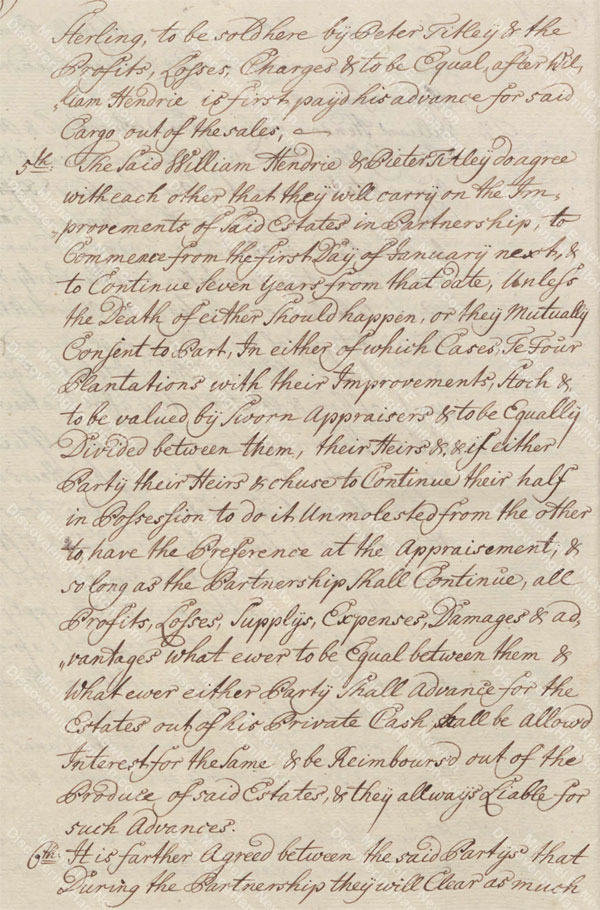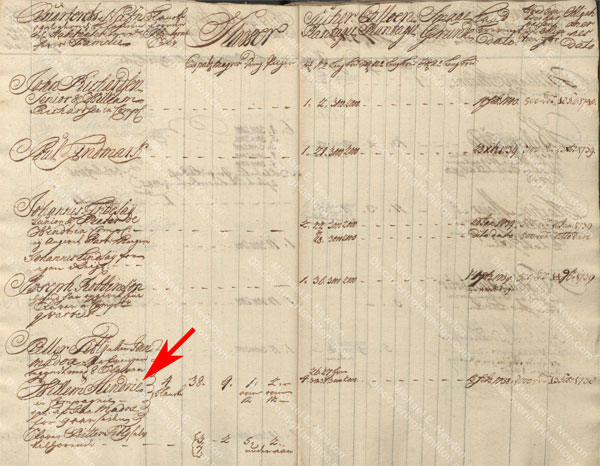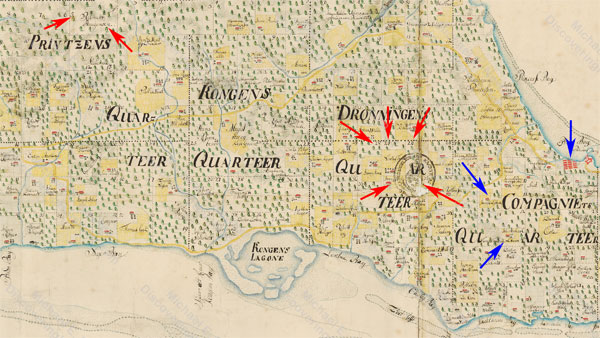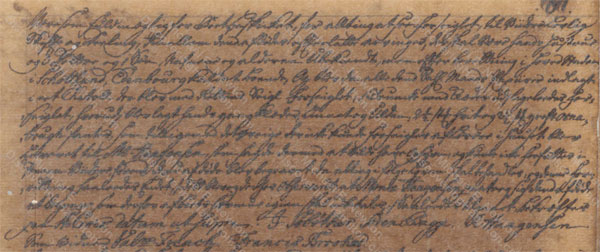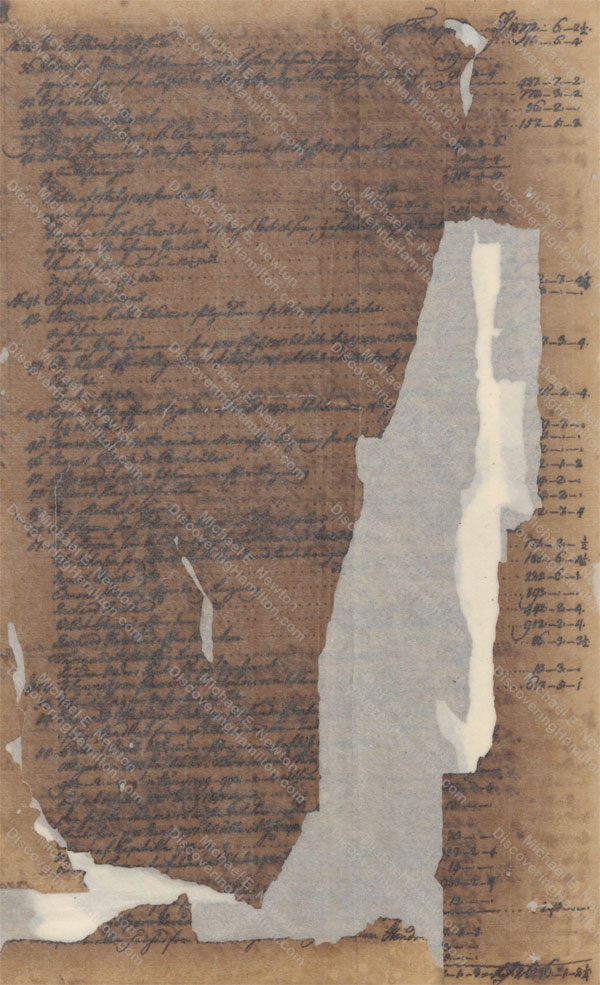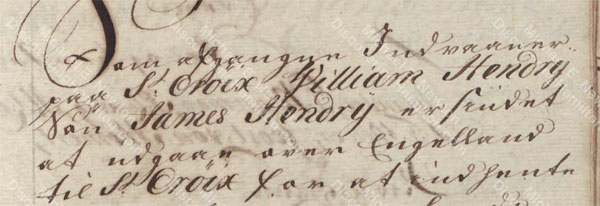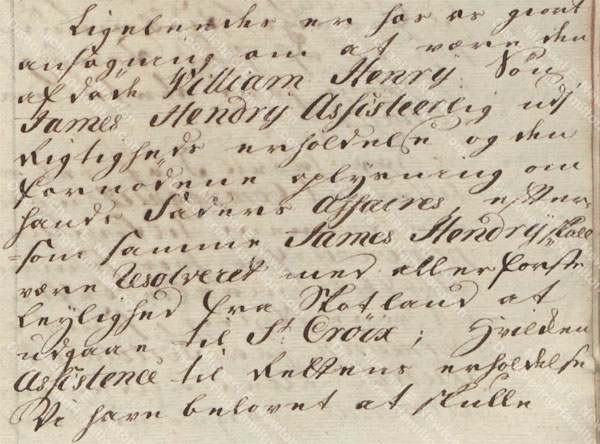Much of the information in this blog (and in all previous Hamilton bios) has been updated, expanded, or even corrected in Michael E. Newton's new book Discovering Hamilton. Please check that book before using or repeating any information you read here on this blog (or that you read in previous Hamilton biographies).
As will be recalled from previous blog posts (see here and here), three people besides Rachel Faucett were summoned in February 1759 “to serve as witnesses” for the divorce of Rachel and John Michael Lavien. They were “James Hendrie, Jemima Gorley, and James Ash.”
It will also be recalled that H. U. Ramsing wrote, “The witnesses who were summoned were all living on St. Croix… They were all people of small means who owned few or no slaves.”[1]
It will be further recalled that based on this, Broadus Mitchell wrote of the witnesses, “Ramsing identified them as persons of no special note; they do not otherwise figure in the records of Rachael.”[2]
But we have already seen that the Jemima Gorley who had been summoned was none other than Jemima Faucett Iles Gurley, the sister of Rachel Faucett (see parts 1, 2, and 3 of her story), and that the summoned James Ash was a relative and was closely associated with the Evans, Lytton, and Faucett families on St. Croix and had repeated personal and business engagements with them (see parts 1 and 2 of his story).
This leaves us with the final summoned witness: James Hendrie.[3]
William Hendrie of St. Kitts Purchases Plantations on St. Croix and Moves There
Before we get to James Hendrie, we’ll first look at a man named William Hendrie.
On June 17, 1744, “William Hendrie merchant in St. Christopher” and “Pieter Titley of St. Croix Surgeon” signed “articles of agreement” whereby Titley agreed to sell to Hendrie on January 1, 1745, “one half of his four plantations situated at Lime Trees…with half of all the buildings, twenty five able negroes, cattle, canes, timber, & improvements.” In exchange, Hendrie agreed to “put on the estates, negroes & [etc.] to the amount of one thousand & fifty pounds sterling” by January 1745 and to pay Titley another 1,050 pounds sterling plus interest “on or before” January 1, 1747. On top of this, Hendrie agreed “to send down a cargo of about five hundred pound sterling to be sold here [on St. Croix] by Peter Titley” with any profits or losses to be split between them. The “articles of agreement” further stipulated that Hendrie and Titley would “carry on the improvements of said estates in partnership” for seven years, unless one dies or they “mutually consent to part,” in which case the four plantations would be “valued by sworn appraisers” and “equally divided.”
William Hendrie is not found in St. Croix’s 1744 matrikel (the annual property, tax, census register) as he apparently stayed on St. Kitts.
Indeed, on September 1, 1745, “in the parish of St. George Basseterre” of St. Kitts, William Hendrie baptized a son and christened him William Jr.[4]
By the end of 1745, William Hendrie is on St. Croix and is listed three times in the island’s matrikel.
1. As per the above Articles of Agreement, William Hendrie is listed as co-owning with Peter Titley four sugar plantations and 50 slaves in Dronningens (Queen’s) Quarter.
According to the subsequent matrikel, these plantations were Nos. 26, 27, 34, and 35 Queen’s Quarter.![]()
2. Hendrie is also listed as the sole owner of another sugar plantation in the same quarter.
According to the subsequent matrikel, this plantation was No. 28 Queen’s Quarter.
3. Hendrie also owned two more sugar plantations in Printzens (Prince’s) Quarter.
According to the subsequent matrikel, these plantations were Nos. 4 and 5 Prince’s Quarter.
One can see the locations of these plantations on the map Johan Cronenberg produced just a few years later. (In the map below, William Hendrie’s plantations are identified by red arrows. For reference, the town of Christiansted and the plantations of James Lytton and John Michael Lavien are indicated by blue arrows.)
Thus, by the end of 1745, William Hendrie owned three sugar plantations by himself and co-owned another four. Apparently, he was a man of some means or at least had credit enough to borrow a substantial amount of money.
William Hendrie’s Death and Probate
Sometime in or before September 1747, William Hendrie died. On September 15, 1747, the probate court took up the matter of his estate.
According to this probate record, William Hendrie had three daughters and one son (see line 3 of the second image above), but their names are not given.[5] It will be recalled from above that William Hendrie had a son William Hendrie Jr., baptized on September 1, 1745, but was this the son to which the probate record referred? (We’ll address that question later.)
Most of the probate records I have seen from St. Croix are long, complicated, and confusing, and William Hendrie’s was no exception. It took nearly two years for the probate court to settle his estate. The probate record runs for 47 pages with each page having about fifty lines of miniscule, crowded, and often sloppy text. In the end, the estate had dozens of creditors and even more debtors with total debits and credits running into the tens of thousands of rigsdalers. On top of this, there was some uncertainty over how the partnership between Peter Titley and William Hendrie would be dissolved.
Here’s a sample page from William Hendrie’s probate record. Not only is the damage to the page quite obvious, but this page also shows how difficult it is to read the text.
In the end, William Hendrie’s estate had credits totaling 48,653 rigsdalers, 7 real, and 2½ styvers versus debts of 74,799rdl 7r, leaving a net debit balance of 26,105rdl 7r 3½st. (As you can see, the table showing this result is very hard to decipher, but I believe these to be the numbers based on this table and figures provided elsewhere in the record.)
Thus, William Hendrie had died a bankrupt to the tune of over twenty-six thousand rigsdalers, his heirs inherited nothing, and many of his creditors recovered just a fraction of what they were owed.
Mary Faucett Collects from William Hendrie’s Estate
According to the above probate record, Maria Facett, better known to us as Mary Faucett, the mother of Rachel Faucett and the grandmother of Alexander Hamilton, submitted a claim against William Hendrie’s estate for 11 rigsdalers for sewing.[6]
Due to the nature of this debt, Mary Faucett collected the full 11rdl owed to her.
It is therefore clear that William Hendrie knew Mary Faucett, but the strength of their relationship is not known.
It will be recalled that Mary Faucett lived in Company’s Quarter from about 1745 to 1750, presumably at the estate of James Lytton or John Michael Lavien. The above map shows that Hendrie’s plantations in Queen’s Quarter were not too far from the Lytton and Lavien estates. William Hendrie must have known the prominent James and Ann Lytton and probably also John Michael and Rachel Lavien, but it is not known how well they knew each other.
James Lytton also appears a number of times in the probate record, both as an assessor and a purchaser of Hendrie’s effects at auction. I found nothing to indicate a relationship between Lytton and Hendrie.
James Hendrie, Son of William Hendrie
The probate record mentioned that William Hendrie had three daughters and one son. One might have assumed that the mentioned son was William Hendrie Jr., who was baptized on St. Kitts on September 1, 1745. But two records written in Copenhagen, Denmark, in December 1749, regarding shipping goods from England or Scotland to St. Croix, show that William Hendrie had a son named James Hendrie. (One assumes, therefore, that William Hendrie Jr. died in infancy.)
Although these records state that James Hendrie was the son of William Hendrie and they called William Hendrie an “inhabitant of St. Croix” (in the first image and elsewhere in the second document), they do not give the whereabouts of James Hendrie.
Was James Hendrie on St. Kitts, where his father had previously lived? Was he in England or Scotland, from where goods were to be sent to St. Croix? Was he in Copenhagen, where these letters were written?
One thing that appears likely is that James Hendrie was not on St. Croix, for not only was he not called an “inhabitant” of that island like his father but he also does not appear in St. Croix’s matrikels nor in any other known record from this island at this time or for many years thereafter.
Perhaps William Hendrie’s wife and children had come with him to St. Croix in 1745 but they returned to St. Kitts after his death. Perhaps James Hendrie, who clearly was an adult in 1749, was already living on his own in 1745 and stayed on St. Kitts when his father moved to St. Croix. Either way, it appears that James Hendrie was not on St. Croix in 1749 and it is likely that he was a resident of St. Kitts, though he may have traveled to England, Scotland, or even Denmark in his capacity as a merchant.
To be continued…
Copyright
© Posted on October 8, 2018, by Michael E. Newton. Please cite this blog post when writing about these new discoveries.
Endnotes
[1] H. U. Ramsing, “Alexander Hamilton og hans Mødrene Slaegt.”
[2] Mitchell, Alexander Hamilton: Youth to Maturity 473 note 46.
[3] Ramsing reported that this third witness was named James Hendricks and Mitchell repeated this error.
[5] The names of William Hendrie’s children are not listed here and I do not see them elsewhere in the probate register, but the record is lengthy and complex and the manuscript is damaged or hardly legible in many places.
[6] This item was discovered and translated by H. U. Ramsing, and shared in H. U. Ramsing, “Alexander Hamilton og hans Mødrene Slaegt.” I probably would not have noticed this barely legible entry on my own.

